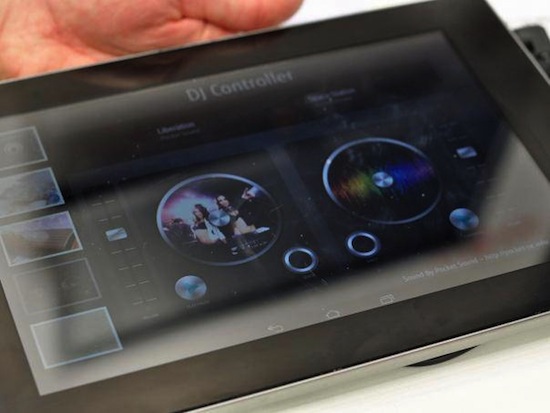The Future Of Control Surfaces? A Touch Screen With Actual Touch
 Fujitsu have announced the development of a prototype tablet with a touchscreen that conveys a sense of slipperiness or roughness depending on the image being displayed using a new haptic, or tactile, sensory technology which they have developed.
Fujitsu have announced the development of a prototype tablet with a touchscreen that conveys a sense of slipperiness or roughness depending on the image being displayed using a new haptic, or tactile, sensory technology which they have developed.
How does haptic technology work?
Inducing an ultrasonic vibration on the surface of the touchscreen display creates a high-pressure layer of air between the screen’s surface and one’s fingertip, which has the effect of reducing friction, creating a floating effect. Taking advantage of this phenomenon makes it possible to create a slippery sensation on a touchscreen display that had been previously difficult to achieve. While vibrations in the ultrasonic band require a significant amount of energy, Fujitsu has developed a technology that induces vibrations efficiently at mobile device sizes, and successfully produced a prototype that creates these tactile sensations.
 By rapidly cycling between high and low friction in response to touch information on the panel and the screen’s display information, this technology can generate a tactile illusion that the screen is bumpy or rough. The combination of tactile information, visual information from the display, and audio information from the speakers enriches the user experience.
By rapidly cycling between high and low friction in response to touch information on the panel and the screen’s display information, this technology can generate a tactile illusion that the screen is bumpy or rough. The combination of tactile information, visual information from the display, and audio information from the speakers enriches the user experience.
A DJ Controller demo as proof of concept
At the Mobile World Congress recently they showed a tablet as a DJ Controller that mimics the sensation of moving a CD placed on a mixing deck, as well as using volume and other controls that feel as if they are sticking out. Other demos showed plucking strings on a harp and opening a safe.
One person that tried it said….
The DJ demo was pretty cool, too, mimicking the feel of a scratching record as I spun it around a turntable.
Another user when they tried the safe demo said…
Testing the dial lock we noticed one issue with the haptic display – it only works if you interact with it using one finger. Trying to physically grab the digital lock with two fingers – like you would in real life – the display only reacted to our index finger.
They then went on to try the strings demo…
We were also impressed with the string demo, and the screen reacted and responded differently to each input we attempted. For example, forcefully plucking one of the digital strings the screen’s feedback was sharper and more forceful than when we smoothly stroked our finger over it.
So it clearly has some merit and some limitations. However we need to remember it is a proof of concept prototype, they aren’t expecting to have real products until some time in 2015. But it could be a solution for those people who don’t like using touchscreen based control surfaces because you can’t feel what you are getting hold of.